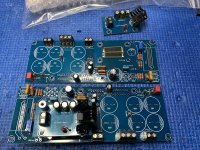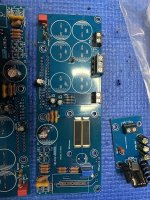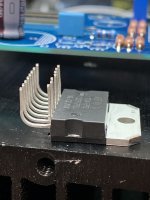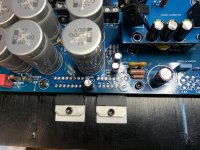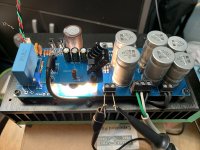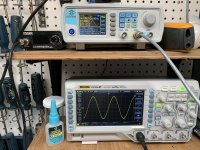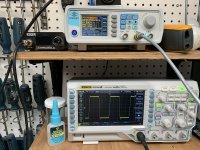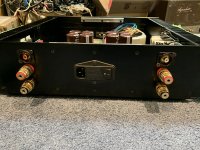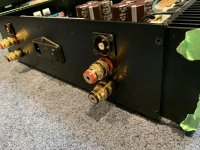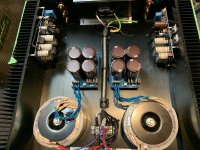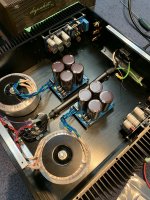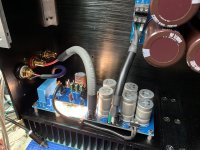That's within spec. It's a 2w resistor.
Sorry about the off-gassing but it should stop.
BTW Surface temperatures are not ambient temperatures. They are expected to be higher.
If it's just too much for you to be comfortable you could do 3 1kohm resistors in parallel, same type of resistors.
Sorry about the off-gassing but it should stop.
BTW Surface temperatures are not ambient temperatures. They are expected to be higher.
If it's just too much for you to be comfortable you could do 3 1kohm resistors in parallel, same type of resistors.
Last edited:
I was just asking, not trying to offend you in any ways...
I’m not understanding this part, what are you trying to say?
“ Sorry about the off-gassing but it should stop.”
Do you mean the smell created by the resistor heating up?
Thanks
Do
It's probably oils from your fingers. If a resistor goes bad it'll crumble very easily. You'll see it change colors and mutate shape.
Don't worry... I've had my shares of burn't resistors in different projects DUT and some output stage blowouts.
If you're ok with the temperature I totally won't worry, I mean it is under specs and the resistor will possibly last a bit less time than if running at 30 Celsius, but really nothing to worry about, i know.
Thanks
Do
If you're ok with the temperature I totally won't worry, I mean it is under specs and the resistor will possibly last a bit less time than if running at 30 Celsius, but really nothing to worry about, i know.
Thanks
Do
When in doubt I just decide to trust the specs if everything measures correct. If I'm still uncomfortable I switch to an alternative like the three resistors way.
In this hobby it's nice to have projects that make like no heat, but I've had some things that are HAF, but just fine for many years.
In this hobby it's nice to have projects that make like no heat, but I've had some things that are HAF, but just fine for many years.
Hi Destroyer OS,
For my own personal use, on low voltage amplifiers such as this one (and I state for my own personal use), I usually let the PSU 0V float and don't connect to chassis because of possible noise injected by AC earth. Since I'm assembling an amplifier for someone else, I will add the PSU 0V to chassis earth using this diode bridge config below for each PSU since it is a dual mono setup.
Do you agree with this config for your design or you prefer a different PSU ground to earth method?
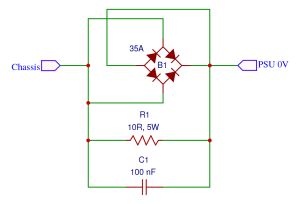
Thanks
Do
For my own personal use, on low voltage amplifiers such as this one (and I state for my own personal use), I usually let the PSU 0V float and don't connect to chassis because of possible noise injected by AC earth. Since I'm assembling an amplifier for someone else, I will add the PSU 0V to chassis earth using this diode bridge config below for each PSU since it is a dual mono setup.
Do you agree with this config for your design or you prefer a different PSU ground to earth method?

Thanks
Do
Hi Destroyer OS,
For my own personal use, on low voltage amplifiers such as this one (and I state for my own personal use), I usually let the PSU 0V float and don't connect to chassis because of possible noise injected by AC earth. Since I'm assembling an amplifier for someone else, I will add the PSU 0V to chassis earth using this diode bridge config below for each PSU since it is a dual mono setup.
Do you agree with this config for your design or you prefer a different PSU ground to earth method?

Thanks
Do
I was also thinking about this (for when I get that far...).
Do you use a ceramic cap for the circuit breaker and do you connect both straight to the chassi ground?
/Hilding
I was also thinking about this (for when I get that far...).
Do you use a ceramic cap for the circuit breaker and do you connect both straight to the chassi ground?
/Hilding
I believe C1 has to be X1 or X2 cap, it is a safety type capacitor of film type.
One side of the circuit goes to your PSU 0V and the other side to chassis earth directly.
Do
Hi Destroyer OS,
For my own personal use, on low voltage amplifiers such as this one (and I state for my own personal use), I usually let the PSU 0V float and don't connect to chassis because of possible noise injected by AC earth. Since I'm assembling an amplifier for someone else, I will add the PSU 0V to chassis earth using this diode bridge config below for each PSU since it is a dual mono setup.
Do you agree with this config for your design or you prefer a different PSU ground to earth method?

Thanks
Do
There's nothing wrong with doing that, but sonic checks are best. I have found not all amps respond the same.
Really nice work BTW. Is that a Silmic II for feedback? If the amp sounds "busy" that would be my first thing I'd look at.
Bold move on the chip legs. How did you do it? I wish you could buy them like that.... really wish you could.
I know it could potentially affect end results on sound but I cannot build an amplifier for someone else and not add the protection. In the end, if Sanjeev decides to disconnect it, it will be at his own risk.
So far it sounds really good. Not at all "busy" with the Silmic II.
Here's some more pics, last one being late night listening!
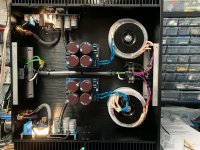
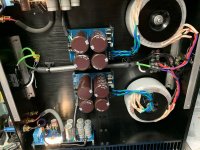
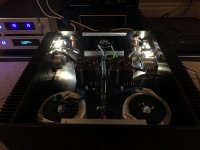
All the best!
Do
So far it sounds really good. Not at all "busy" with the Silmic II.
Here's some more pics, last one being late night listening!



All the best!
Do
Last edited:
Only one thing though... The right Antek transformer has a mechanical buzz that disappears when I squeeze it with my hands but then comes back after 20-30 seconds... I don't know if it is defective... It is not super loud but enough to hear it at 2-3 feet away with cover open. It does translate into a little noise on the right channel. Left channel is very silent, both are connected the same... I'm thinking to not connect the toroid screen to earth... Any other ideas? I don't think it is DC injected into the AC because both transformers would buzz.
Do
Do
You can try the screen but maybe its the gauss band. Why not get large zip ties to apply? It’s not exactly a defect worth ordering a new transformer over if we already know the fix.
I just tried zip ties but it does not work. Possible because the transformer does not have even surfaces around it. I will try adding a thick foam around it and zip ties, this should force it to put better pressure everywhere.
Thanks
Do
- Home
- Group Buys
- Folsom EC7293: PVI Powered Frontend, 60/120w 8/4ohm
